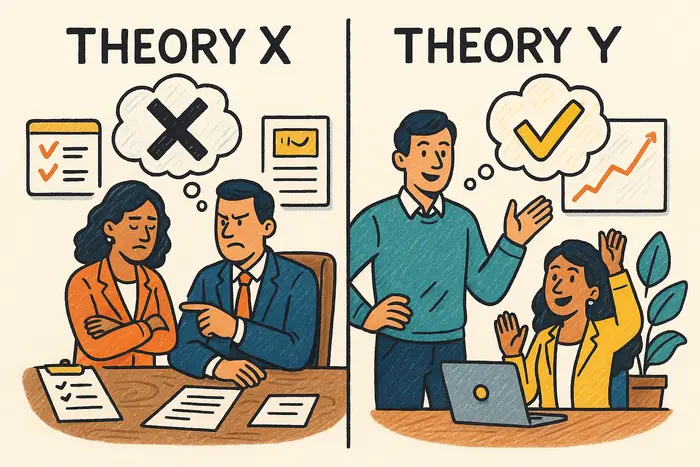Theory X and Theory Y: Understanding Two Opposing Management Styles
When it comes to leading people, your management style is often shaped by your beliefs about motivation and human behavior. This idea was famously captured by Douglas McGregor in the 1960s through Theory X and Theory Y—two contrasting views on how people approach work.
Understanding these theories can help you reflect on your own leadership style, manage your team more effectively, and build a better workplace culture.
What Are Theory X and Theory Y?
McGregor proposed that managers generally fall into two categories based on their assumptions about employees:
Theory X Assumptions:
- People inherently dislike work and will avoid it if possible
- Most people prefer to be directed rather than take responsibility
- Motivation comes primarily from external control (e.g., rules, threats, punishment)
- Managers must be authoritative and closely supervise employees
Theory Y Assumptions:
- People find work as natural as play or rest
- Individuals will take responsibility and show initiative when motivated
- People are capable of self-direction and self-control
- Motivation comes from within (e.g., achievement, purpose, autonomy)
Theory X vs. Theory Y: A Quick Comparison
| Aspect | Theory X | Theory Y |
|---|---|---|
| View of Employees | Lazy, unmotivated | Self-motivated, capable |
| Leadership Style | Authoritative, top-down | Participative, empowering |
| Motivation Tactic | External (rules, fear) | Internal (purpose, growth) |
| Supervision | Close monitoring | Trust and delegation |
| Suitable For | Routine, repetitive jobs | Creative, knowledge-based work |
When to Use Each Approach
While Theory Y is generally favored in modern management, there are situations where elements of Theory X might still apply.
Use Theory X when:
- Work is highly structured or dangerous
- Strict compliance is necessary
- Employees are new, untrained, or not self-motivated (yet)
Use Theory Y when:
- Work requires creativity, problem-solving, or innovation
- You want to build trust, engagement, and accountability
- Your team is skilled and seeks autonomy
Applying Theory X and Theory Y in Real Life
Rather than choosing one theory over the other, effective managers often adapt their style depending on the situation and individuals they lead.
Tips for applying Theory Y effectively:
- Involve employees in decision-making
- Provide opportunities for growth and learning
- Set clear goals, then trust your team to deliver
If Theory X tendencies are needed:
- Use them sparingly and transparently
- Balance control with respect and support
- Transition employees toward more autonomy as they develop
Summary: Know Your Beliefs, Then Lead with Intention
Theory X and Theory Y are more than academic concepts—they reflect how we view people and shape how we lead. By being aware of these assumptions, you can better tailor your leadership to your team’s needs and build a more effective, motivated workplace.
Key Takeaways:
- Theory X = control and structure; Theory Y = trust and empowerment
- Most modern workplaces benefit from a Theory Y approach
- Great leaders adjust their style based on context and individual readiness
